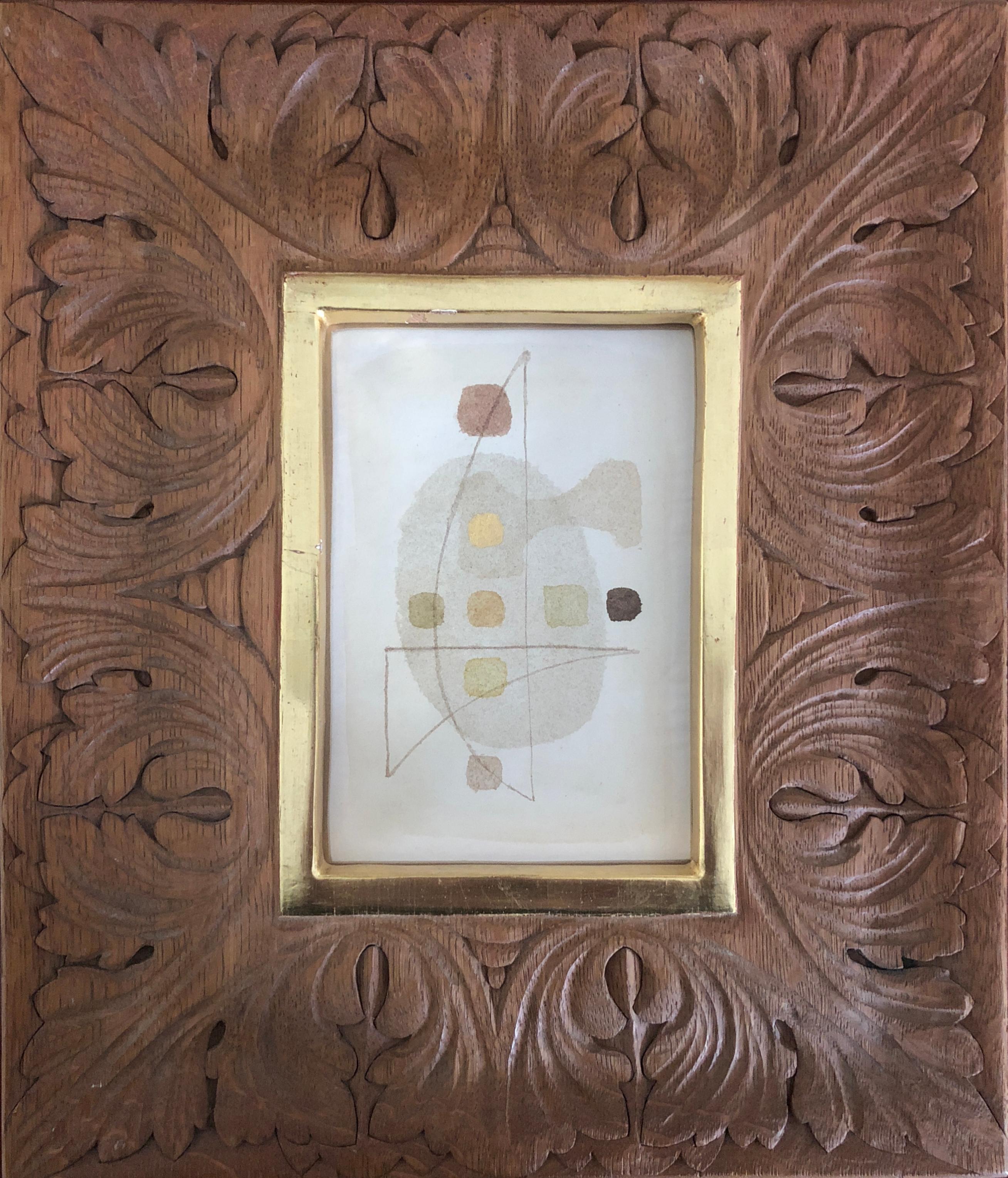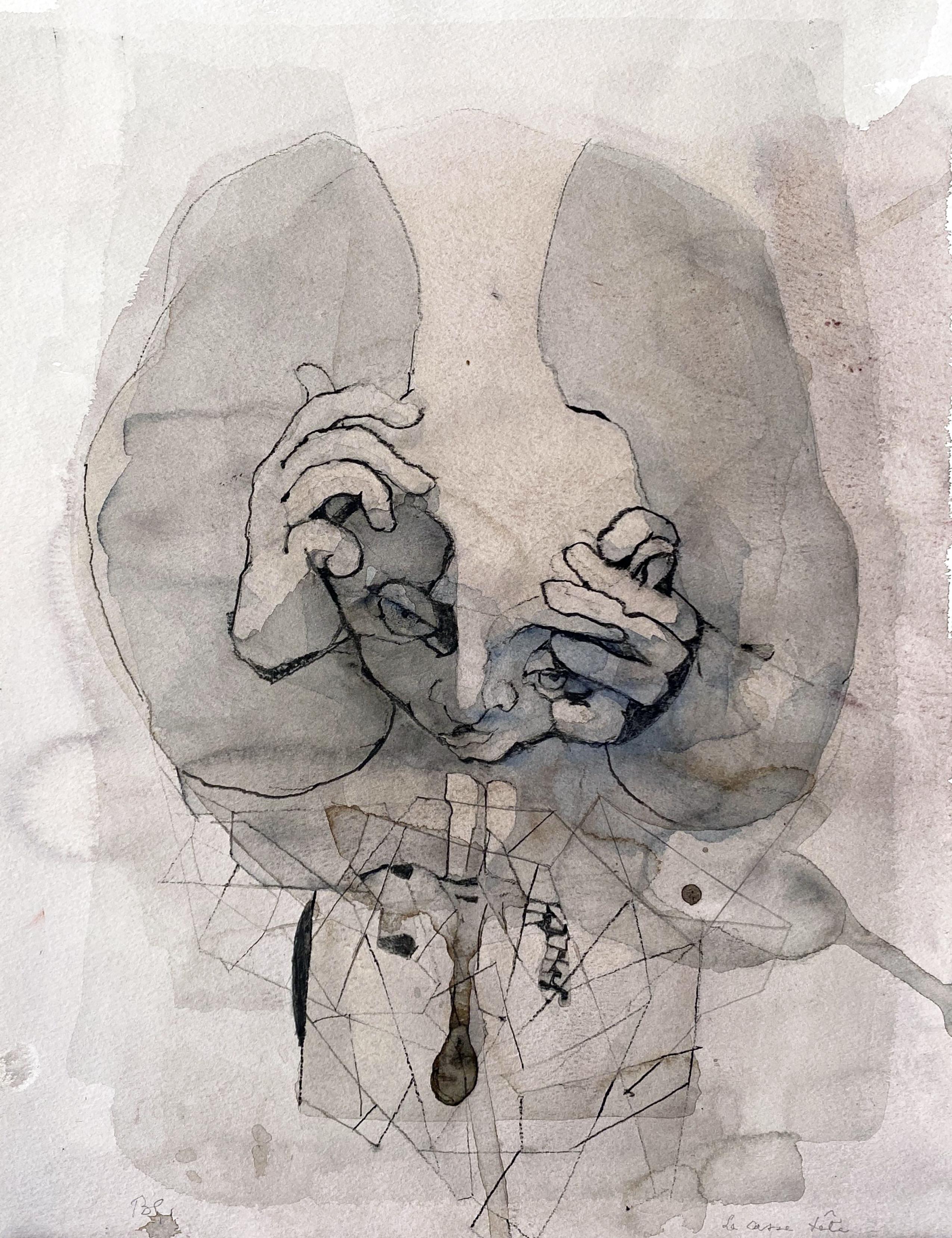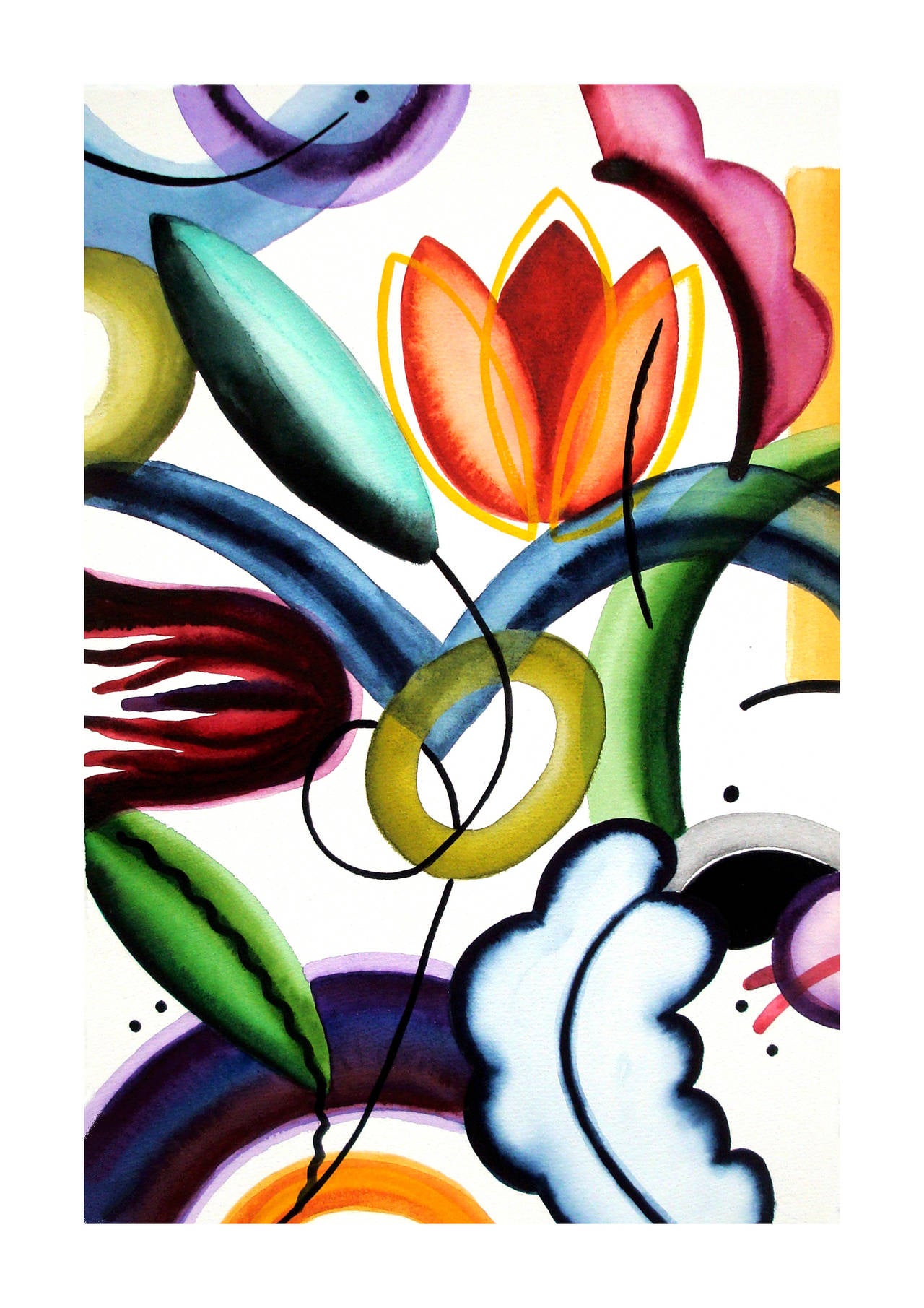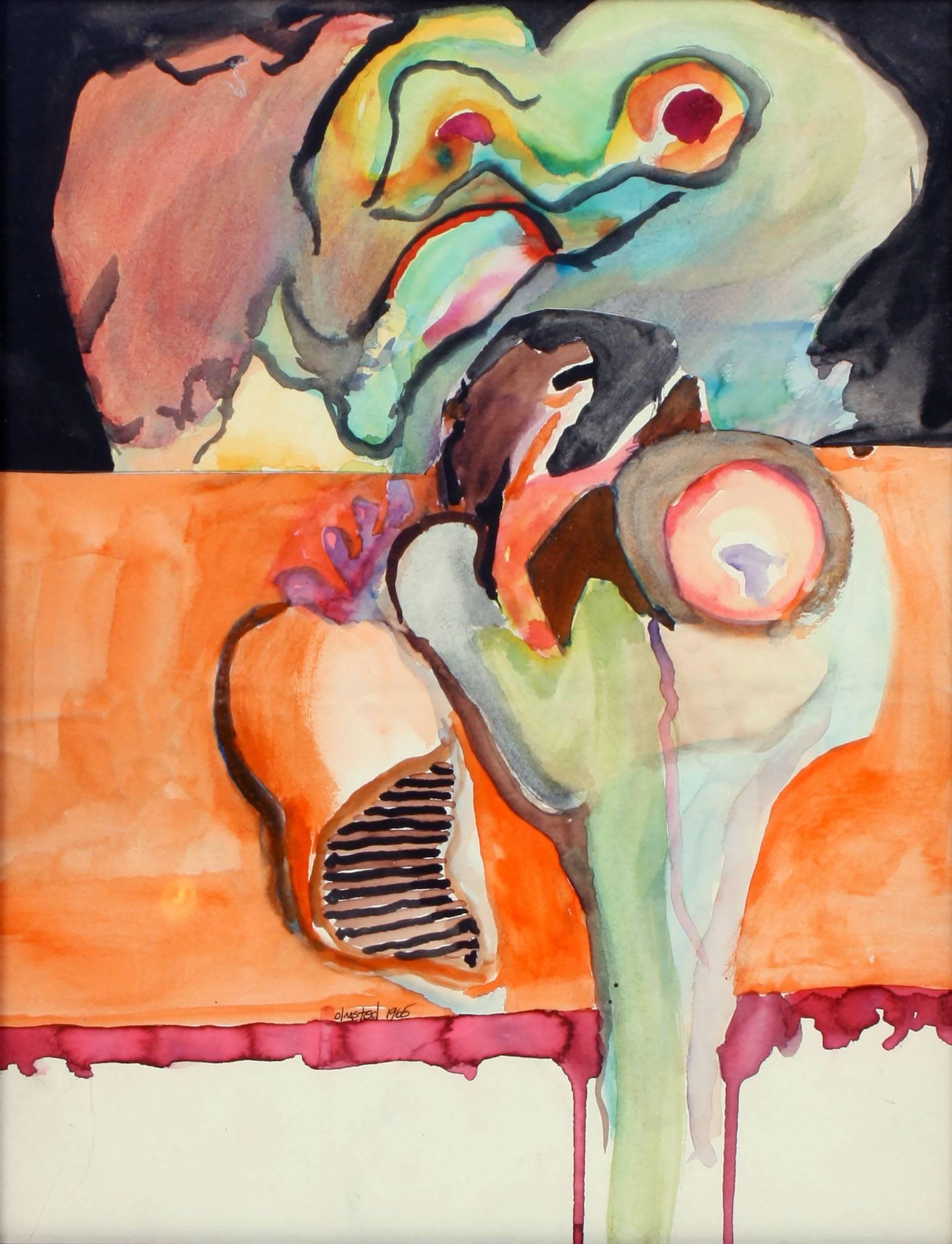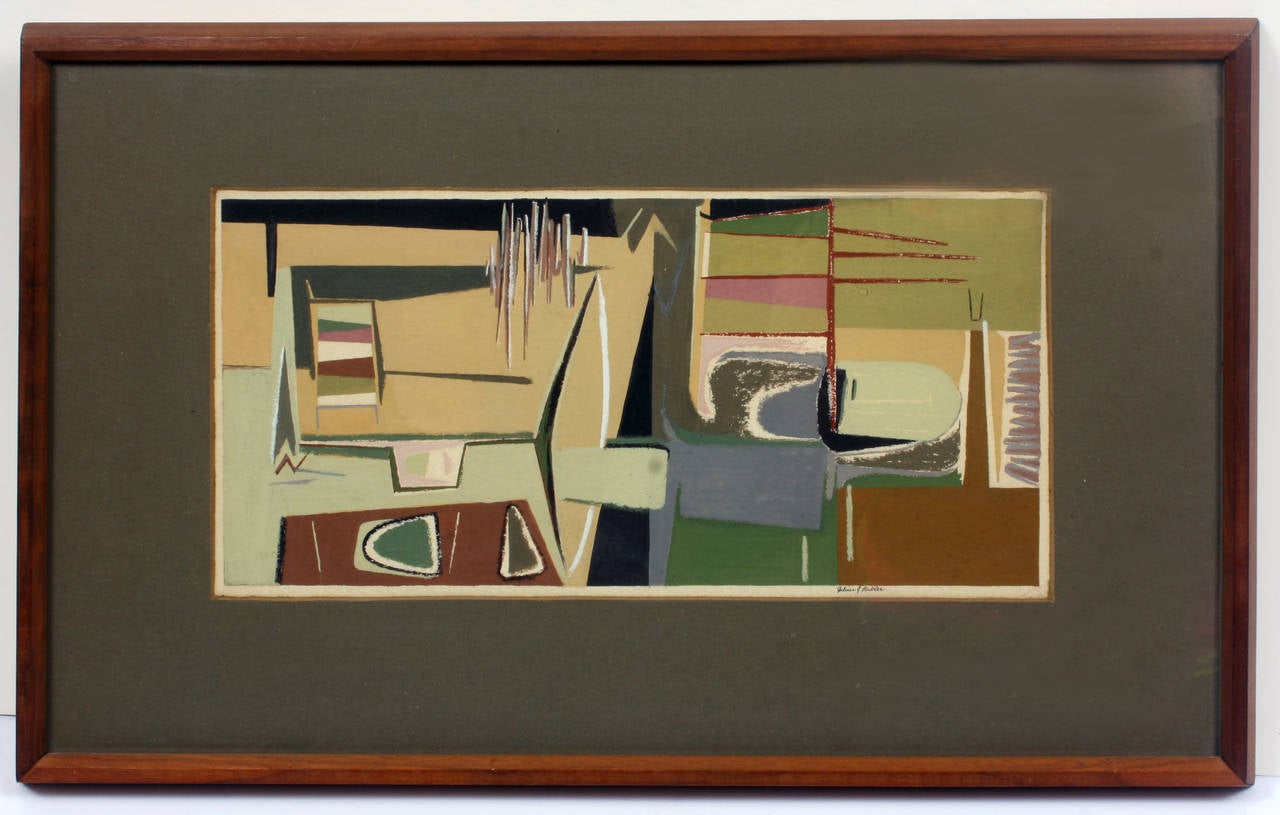Items Similar to 1950's Modernist Watercolor Painting Israeli Bezalel School Bauhaus Style
Want more images or videos?
Request additional images or videos from the seller
1 of 8
Louise Schatz1950's Modernist Watercolor Painting Israeli Bezalel School Bauhaus Style1959
1959
About the Item
Louise (McClure) Schatz (1916 – 1997) Born in Vancouver, Canada, Louise Schatz moved with her family at age three to Minnesota. Her father, a stage director, was part of the local Bohemian culture and traveled the theater circuit around the U.S. She earned a Master’s Degree in Fine Arts at the University of California, where she became a skilled water colorist. “My Japanese instructor showed me how to preserve several colors together on paper,” she noted. “Water colors can bleed into the paper, and the paper plays with the colors – some of which can even disappear. I have a great love of texture and what materials do to color. I was very excited to discover what happens to colors and how to achieve what I wanted.” Her interest in astronomy also led Louise to study science at the university. Louise joined the “California Seven” artists in 1945 and for the next three years created prints and textile patterns. During WWII, she earned her living as a sketch artist for ship builders in San Francisco Bay, and it was there she met her future husband, Bezalel. “Then, it was very avant-garde to hire women in ship-building,” she once recounted. “We used to take dimensions from engineers and make sketches. It was very trailblazing and exciting, and the ships were constructed very quickly and launched very quickly. Besides the fact that we contributed to the war effort, it was really beautiful art.” The Bohemian society developing in San Francisco at the time included the novelist Henry Miller, who was then married to Louise’s sister, Eve. “There was a group of artists in Big Sur, all of them poor,” according to Bezalel Schatz’s sister, Zohara. “They were a group of Beatniks before the hippy era of the 1960s. There were novelists, poets, and painters there who lived communally under primitive conditions and were close to nature.” Bezalel and Louise were married in 1948 and moved to Israel. There, together with Zohara, they founded the arts and crafts workshop, “Yad,” with the goal of creating and selling alternative art objects that differed in style from those of the Bezalel School of Art. The couple divided its time between the family home in Jerusalem and a residence in Ein Hod designed for them by the architect David Resnik. Despite her connection to the Schatz family and her active involvement in the Israeli art world at the time, Louise guarded her privacy and rarely granted interviews. As Henry Miller wrote, “Her paintings reflect and reveal the extent of her sensitivity, shyness, and gentleness…” Scenes of Israel were a source of inspiration for Louise, and, in addition to her abstract Bauhaus geometric works, she also painted landscapes, flowers, and other elements of the environment in which she worked. Louise worked mainly in water colors but also created collages, book illustrations, and applied art. Among her outstanding works are murals for Zim’s “Shalom” and “Theodore Herzl” ships (together with Bezalel), El Al’s London office, and Jerusalem’s tenth anniversary exhibition, as well as ceramic walls for Jerusalem’s Midreshet Amalia and Beit Ha’am Library. She was awarded the Silver Medal in 1954 at the tenth Triennale in Milan for her copper designs, and in 1952 she received the “Above Competition” prize for her textile designs at the Bezalel National Museum. She was also awarded the Shen Beit Haomanim Prize in 1970 and the Jerusalem Prize for painting in 1973. Louise took part in many art exhibitions in Israel and abroad. Her works are held by the Israel, Tel Aviv, and Haifa Museums, and in private collections in Israel, the U.S., England, Switzerland, France, and Italy. Following her husband’s death in 1978, Louise continued to live with her sister-in-law, Zohara, at the family home in Jerusalem on Schatz Street. Louise died in Jerusalem in 1997.
She has been called in the pages of the Jerusalem Post " the greatest Schatz of all" and "Israel's finest watercolorist" Parts of her work summon up affinities with Paul Klee and Julius Bissier and occasionally even Joan Miro. But she never copied any of them. Her work also bears affinities for Lyonel Feininger and Wassily Kandinsky
Between 1937 and 1951, Bezalel resided in the U.S. Near the end of WWII, he worked in a California shipyard, and it was there he met his future wife, Louise. He was also introduced to the novelist Henry Miller in California, and their friendship blossomed into a creative collaboration. The artist May Ray recorded his observations about the two, noting that “I have never encountered such smooth cooperation…” Bezalel produced silkscreen prints for Miller’s novel, Into the Night Life, an innovation for both the art and publishing worlds. In Florence, New Mexico, New York, San Francisco, and other locations, Bezalel exhibited his own work and participated in group shows with some of the greatest artists of his era – Picasso, Matisse, Chagall, and Kokoschka.
Bezalel and Louise married in 1948 and moved to Israel three years later, taking residence in the Schatz house in Jerusalem. Despite his long absence from Israel and his conceptual conflicts with artists there, Bezalel mounted several exhibitions and represented his native country abroad – in Germany and at Venice’s 1954 Biennale, for example. Together with Louise and his sister, Zohara, he established the arts and crafts workshop, “Yad.” Objects created there today are displayed and sold in a small building on the grounds of the family home on Bezalel Street in Jerusalem. When the Ein Hod artists’ village was founded in 1953, Bezalel and Louise moved to a home designed for them there by Israeli architect David Reznik. The couple melded easily into the village’s Bohemian artistic life, which resembled the lifestyle they had adopted in California.
- Creator:Louise Schatz (1916 - 1997)
- Creation Year:1959
- Dimensions:Height: 6.5 in (16.51 cm)Width: 20.5 in (52.07 cm)
- Medium:
- Movement & Style:
- Period:
- Condition:good. minor wear. please see photos.
- Gallery Location:Surfside, FL
- Reference Number:1stDibs: LU38213822722
About the Seller
4.9
Platinum Seller
These expertly vetted sellers are 1stDibs' most experienced sellers and are rated highest by our customers.
Established in 1995
1stDibs seller since 2014
1,547 sales on 1stDibs
Typical response time: 1 hour
- ShippingRetrieving quote...Ships From: Surfside, FL
- Return PolicyA return for this item may be initiated within 3 days of delivery.
More From This SellerView All
- Modernist Abstract Expressionist Watercolor Painting Bauhaus Weimar ArtistBy Pawel KontnyLocated in Surfside, FLAbstract watercolor composition bearing the influence of the earlier color-block compositions of Paul Klee. Pawel August Kontny, (Polish-German-American artist) He was born in Laurahuette, Poland, in 1923, the son of a wealthy pastry shop owner. In 1939 he began studying architecture in Breslau where he was introduced to the European masters and to the work of some of the German Expressionists, soon afterward banned as "degenerate artists" and removed from museums throughout Germany by the Nazi regime. His studies were interrupted by World War II. Drafted into the German army, traveling in many countries as a soldier, he sketched various landscapes but in 1945, he was captured and held as a prisoner of war in Italy. After the war, he studied at the Union of Nuremberg Architects to help design buildings to replace ones destroyed in the war. He recorded his impressions of the local population and the landscapes through his watercolors and drawings. Pawel Kontny thereafter moved to Nuremberg, Germany, becoming a member of the Union of Nuremberg Architects and helping to rebuild the city's historic center. He soon decided to concentrate on his professional art career. He married Irmgard Laurer, a dancer with the Nuremberg Opera. Pavel Kontny 's career as an artist was launched with his participation in an all German exhibition, held at the Dusseldorf Museum in 1952. He held one-man shows in Germany, Switzerland and the United States. During his trip to the United States in 1960, Kontny became instantly enamored with Colorado, and decided to relocate to Cherry Hills with his wife and two children. He quickly established himself in the local art community, being affiliated for a time with Denver Art Galleries and Saks Galleries. His subject matter became the Southwest. During this time he received the Prestigious Gold Medal of the Art Academy of Rome. His extensive travel provided material for the paintings he did using his hallmark marble dust technique. he also worked equally in pastel, watercolor, charcoal and pencil-and-ink. in a style which merged abstraction and realist styles, influenced by Abstract Expressionist painting and South Western American landscapes. In the early 1960s he was one of only a few European-born professional artists in the state, a select group that included Herbert Bayer (1900-1985), a member of the prewar Bauhaus in Weimar and Dessau, Germany, and Roland Detre (1903-2001), a Hungarian modernist painter. As a Denver, Colorado resident, Pavel Kontny exhibited at galleries and museums throughout the United States, Germany and Japan. There, he was inspired by frequent trips to Native American pueblos in the Southwest, as well as by the study of the Plains Indians of Montana and Wyoming. Over the years Kontny had a number of students and generously helped young artist by hosting exhibitions at his Cherry Hills home. For many years he generously donated his paintings to support charitable causes in Denver. Influences during his European years included German pastelist C.O. Muller, German Informel painter Karl Dahmen and Swiss artist, Hans Erni. In the early 1950s his painting style showed the influence of the Die Brücke (The Bridge), a group of German expressionist artists formed in Dresden in 1905 who had a major impact on the evolution of modern art in the twentieth century in Germany. By the middle of the decade his style incorporated more referential abstraction and total abstraction, resulting in part from his study of Hans Hartung, a German artist based in Paris who exhibited his gestural abstract work in Germany. His work also bears the influence of Sam Francis. The American moon landing in 1969 inspired Paul Kontny...Category
Mid-20th Century American Modern Abstract Drawings and Watercolors
MaterialsWatercolor, Archival Paper
- Modernist Abstract Expressionist Watercolor Painting Bauhaus Weimar Pawel KontnyBy Pawel KontnyLocated in Surfside, FLAbstract watercolor composition bearing the influence of the earlier color-block compositions of Paul Klee. Pawel August Kontny, (Polish-German-American artist) He was born in Laurahuette, Poland, in 1923, the son of a wealthy pastry shop owner. In 1939 he began studying architecture in Breslau where he was introduced to the European masters and to the work of some of the German Expressionists, soon afterward banned as "degenerate artists" and removed from museums throughout Germany by the Nazi regime. His studies were interrupted by World War II. Drafted into the German army, traveling in many countries as a soldier, he sketched various landscapes but in 1945, he was captured and held as a prisoner of war in Italy. After the war, he studied at the Union of Nuremberg Architects to help design buildings to replace ones destroyed in the war. He recorded his impressions of the local population and the landscapes through his watercolors and drawings. Pawel Kontny thereafter moved to Nuremberg, Germany, becoming a member of the Union of Nuremberg Architects and helping to rebuild the city's historic center. He soon decided to concentrate on his professional art career. He married Irmgard Laurer, a dancer with the Nuremberg Opera. Pavel Kontny 's career as an artist was launched with his participation in an all German exhibition, held at the Dusseldorf Museum in 1952. He held one-man shows in Germany, Switzerland and the United States. During his trip to the United States in 1960, Kontny became instantly enamored with Colorado, and decided to relocate to Cherry Hills with his wife and two children. He quickly established himself in the local art community, being affiliated for a time with Denver Art Galleries and Saks Galleries. His subject matter became the Southwest. During this time he received the Prestigious Gold Medal of the Art Academy of Rome. His extensive travel provided material for the paintings he did using his hallmark marble dust technique. he also worked equally in pastel, watercolor, charcoal and pencil-and-ink. in a style which merged abstraction and realist styles, influenced by Abstract Expressionist painting and South Western American landscapes. This one bears the influence of Sam Francis. In the early 1960s he was one of only a few European-born professional artists in the state, a select group that included Herbert Bayer (1900-1985), a member of the prewar Bauhaus in Weimar and Dessau, Germany, and Roland Detre (1903-2001), a Hungarian modernist painter. As a Denver, Colorado resident, Pavel Kontny exhibited at galleries and museums throughout the United States, Germany and Japan. There, he was inspired by frequent trips to Native American pueblos in the Southwest, as well as by the study of the Plains Indians of Montana and Wyoming. Over the years Kontny had a number of students and generously helped young artist by hosting exhibitions at his Cherry Hills home. For many years he generously donated his paintings to support charitable causes in Denver. Influences during his European years included German pastelist C.O. Muller, German Informel painter Karl Dahmen and Swiss artist, Hans Erni. In the early 1950s his painting style showed the influence of the Die Brücke (The Bridge), a group of German expressionist artists formed in Dresden in 1905 who had a major impact on the evolution of modern art in the twentieth century in Germany. By the middle of the decade his style incorporated more referential abstraction and total abstraction, resulting in part from his study of Hans Hartung, a German artist based in Paris who exhibited his gestural abstract work in Germany. The American moon landing in 1969 inspired Paul Kontny...Category
20th Century American Modern Abstract Drawings and Watercolors
MaterialsWatercolor, Archival Paper
- Modernist Abstract Expressionist Watercolor Painting Bauhaus Weimar Pawel KontnyBy Pawel KontnyLocated in Surfside, FLAbstract watercolor composition bearing the influence of the earlier color-block compositions of Paul Klee. Pawel August Kontny, (Polish-German-American artist) He was born in Laurahuette, Poland, in 1923, the son of a wealthy pastry shop owner. In 1939 he began studying architecture in Breslau where he was introduced to the European masters and to the work of some of the German Expressionists, soon afterward banned as "degenerate artists" and removed from museums throughout Germany by the Nazi regime. His studies were interrupted by World War II. Drafted into the German army, traveling in many countries as a soldier, he sketched various landscapes but in 1945, he was captured and held as a prisoner of war in Italy. After the war, he studied at the Union of Nuremberg Architects to help design buildings to replace ones destroyed in the war. He recorded his impressions of the local population and the landscapes through his watercolors and drawings. Pawel Kontny thereafter moved to Nuremberg, Germany, becoming a member of the Union of Nuremberg Architects and helping to rebuild the city's historic center. He soon decided to concentrate on his professional art career. He married Irmgard Laurer, a dancer with the Nuremberg Opera. Pavel Kontny 's career as an artist was launched with his participation in an all German exhibition, held at the Dusseldorf Museum in 1952. He held one-man shows in Germany, Switzerland and the United States. During his trip to the United States in 1960, Kontny became instantly enamored with Colorado, and decided to relocate to Cherry Hills with his wife and two children. He quickly established himself in the local art community, being affiliated for a time with Denver Art Galleries and Saks Galleries. His subject matter became the Southwest. During this time he received the Prestigious Gold Medal of the Art Academy of Rome. His extensive travel provided material for the paintings he did using his hallmark marble dust technique. he also worked equally in pastel, watercolor, charcoal and pencil-and-ink. in a style which merged abstraction and realist styles, influenced by Abstract Expressionist painting and South Western American landscapes. This one bears the influence of Sam Francis. In the early 1960s he was one of only a few European-born professional artists in the state, a select group that included Herbert Bayer (1900-1985), a member of the prewar Bauhaus in Weimar and Dessau, Germany, and Roland Detre (1903-2001), a Hungarian modernist painter. As a Denver, Colorado resident, Pavel Kontny exhibited at galleries and museums throughout the United States, Germany and Japan. There, he was inspired by frequent trips to Native American pueblos in the Southwest, as well as by the study of the Plains Indians of Montana and Wyoming. Over the years Kontny had a number of students and generously helped young artist by hosting exhibitions at his Cherry Hills home. For many years he generously donated his paintings to support charitable causes in Denver. Influences during his European years included German pastelist C.O. Muller, German Informel painter Karl Dahmen and Swiss artist, Hans Erni. In the early 1950s his painting style showed the influence of the Die Brücke (The Bridge), a group of German expressionist artists formed in Dresden in 1905 who had a major impact on the evolution of modern art in the twentieth century in Germany. By the middle of the decade his style incorporated more referential abstraction and total abstraction, resulting in part from his study of Hans Hartung, a German artist based in Paris who exhibited his gestural abstract work in Germany. The American moon landing in 1969 inspired Paul Kontny...Category
20th Century American Modern Abstract Drawings and Watercolors
MaterialsWatercolor, Archival Paper
- Modernist Abstract Expressionist Watercolor Painting Bauhaus Weimar Pawel KontnyBy Pawel KontnyLocated in Surfside, FLAbstract watercolor composition bearing the influence of the earlier color-block compositions of Paul Klee. Pawel August Kontny, (Polish-German-American artist) He was born in Laurahuette, Poland, in 1923, the son of a wealthy pastry shop owner. In 1939 he began studying architecture in Breslau where he was introduced to the European masters and to the work of some of the German Expressionists, soon afterward banned as "degenerate artists" and removed from museums throughout Germany by the Nazi regime. His studies were interrupted by World War II. Drafted into the German army, traveling in many countries as a soldier, he sketched various landscapes but in 1945, he was captured and held as a prisoner of war in Italy. After the war, he studied at the Union of Nuremberg Architects to help design buildings to replace ones destroyed in the war. He recorded his impressions of the local population and the landscapes through his watercolors and drawings. Pawel Kontny thereafter moved to Nuremberg, Germany, becoming a member of the Union of Nuremberg Architects and helping to rebuild the city's historic center. He soon decided to concentrate on his professional art career. He married Irmgard Laurer, a dancer with the Nuremberg Opera. Pavel Kontny 's career as an artist was launched with his participation in an all German exhibition, held at the Dusseldorf Museum in 1952. He held one-man shows in Germany, Switzerland and the United States. During his trip to the United States in 1960, Kontny became instantly enamored with Colorado, and decided to relocate to Cherry Hills with his wife and two children. He quickly established himself in the local art community, being affiliated for a time with Denver Art Galleries and Saks Galleries. His subject matter became the Southwest. During this time he received the Prestigious Gold Medal of the Art Academy of Rome. His extensive travel provided material for the paintings he did using his hallmark marble dust technique. he also worked equally in pastel, watercolor, charcoal and pencil-and-ink. in a style which merged abstraction and realist styles, influenced by Abstract Expressionist painting and South Western American landscapes. This one bears the influence of Sam Francis. In the early 1960s he was one of only a few European-born professional artists in the state, a select group that included Herbert Bayer (1900-1985), a member of the prewar Bauhaus in Weimar and Dessau, Germany, and Roland Detre (1903-2001), a Hungarian modernist painter. As a Denver, Colorado resident, Pavel Kontny exhibited at galleries and museums throughout the United States, Germany and Japan. There, he was inspired by frequent trips to Native American pueblos in the Southwest, as well as by the study of the Plains Indians of Montana and Wyoming. Over the years Kontny had a number of students and generously helped young artist by hosting exhibitions at his Cherry Hills home. For many years he generously donated his paintings to support charitable causes in Denver. Influences during his European years included German pastelist C.O. Muller, German Informel painter Karl Dahmen and Swiss artist, Hans Erni. In the early 1950s his painting style showed the influence of the Die Brücke (The Bridge), a group of German expressionist artists formed in Dresden in 1905 who had a major impact on the evolution of modern art in the twentieth century in Germany. By the middle of the decade his style incorporated more referential abstraction and total abstraction, resulting in part from his study of Hans Hartung, a German artist based in Paris who exhibited his gestural abstract work in Germany. The American moon landing in 1969 inspired Paul Kontny...Category
20th Century American Modern Abstract Drawings and Watercolors
MaterialsWatercolor, Archival Paper
- Polish French Judaica Watercolor Gouache Painting Original Bauhaus Yiddish ArtBy Moses Bagel BahelferLocated in Surfside, FLMoses Bahelfer BAGEL (1908-1995) Moses Bagel (born Moshe Bahelfer) was a Polish-born Jewish artist and graphic designer associated with the original Bauhaus and then the School of Paris (Ecole de Paris) Moshe Bagelferyches was born on June 29 , 1908 in Vilnius, (Vilna, Poland) then part of the Russian Empire. He took up painting from at an early age, later going on to work as an apprentice at a local vocational school in Vilno while taking classes at the Vilnius Academy of Arts. Bagelferyches also joined Yungvilno, a group formed by young Jewish artists, poets and writers in the city, who hosted exhibitions. In 1927, he left for Germany where he joined the Bauhaus arts and architecture school in Dessau. From 1928 to 1932, he studied under Joost Schmidt, Paul Klee, Lyonel Feininger, and Wassily Kandinsky. His painting was close to pure abstract art. He maintained close bonds with former students of the Bauhaus school who lived in Paris, Joseph Weinfeld, Jean Leppien...Category
20th Century Modern Figurative Drawings and Watercolors
MaterialsInk, Watercolor, ABS
- Polish French Judaica Watercolor Gouache Painting Original Bauhaus Yiddish ArtBy Moses Bagel BahelferLocated in Surfside, FLMoses Bahelfer BAGEL (1908-1995) Moses Bagel (born Moshe Bahelfer) was a Polish-born Jewish artist and graphic designer associated with the original Bauhaus and then the School of Paris (Ecole de Paris) Moshe Bagelferyches was born on June 29 , 1908 in Vilnius, (Vilna, Poland) then part of the Russian Empire. He took up painting from at an early age, later going on to work as an apprentice at a local vocational school in Vilno while taking classes at the Vilnius Academy of Arts. Bagelferyches also joined Yungvilno, a group formed by young Jewish artists, poets and writers in the city, who hosted exhibitions. In 1927, he left for Germany where he joined the Bauhaus arts and architecture school in Dessau. From 1928 to 1932, he studied under Joost Schmidt, Paul Klee, Lyonel Feininger, and Wassily Kandinsky. His painting was close to pure abstract art. He maintained close bonds with former students of the Bauhaus school who lived in Paris, Joseph Weinfeld, Jean Leppien...Category
20th Century Modern Figurative Drawings and Watercolors
MaterialsInk, Watercolor, ABS
You May Also Like
- Untitled Abstraction with Gold by Annemarie GraupnerLocated in Hudson, NYMinimalist work by Annemarie Graupner, in a charming hand-carved wood frame. Perfect for an intimate nook. About this artist: Swiss artist Annemarie Graupner, granddaughter of the S...Category
20th Century Modern Abstract Drawings and Watercolors
MaterialsGold Leaf
- Benoît Gilsoul "Mind Puzzle", original ink and watercolor on paperBy Benoît GilsoulLocated in Glenview, IL"Mind Puzzle (Le Casse Tête)" by Belgian artist Benoît Gilsoul a watercolor and ink on paper representing a human figure bent over and holding his head...Category
1960s Modern Abstract Drawings and Watercolors
MaterialsWatercolor, Ink
- ValleyBy Ellen SteinfeldLocated in Buffalo, NYEllen Steinfeld is a sculptor, a painter and has worked in several different media. She graduated with a degree in painting and design from Carnegie Mellon University and earned a graduate degree from the University of Pittsburgh. She has received numerous large-scale public and private commissions including an 18’ steel sculpture for the atrium of Roswell Park Cancer Institute and a commission to design 16 large stained glass windows for Christ Church in Detroit. Works in various media have been selected and incorporated into public spaces including schools, hotels, hospitals, museums, airports, stadiums and corporate collections. Her work was selected to represent New York State for the Absolut...Category
21st Century and Contemporary American Modern Abstract Drawings and Wate...
MaterialsHandmade Paper, Watercolor
- WhirlBy Ellen SteinfeldLocated in Buffalo, NYEllen Steinfeld is a sculptor, a painter and has worked in several different media. She graduated with a degree in painting and design from Carnegie Mellon University and earned a graduate degree from the University of Pittsburgh. She has received numerous large-scale public and private commissions including an 18’ steel sculpture for the atrium of Roswell Park Cancer Institute and a commission to design 16 large stained glass windows for Christ Church in Detroit. Works in various media have been selected and incorporated into public spaces including schools, hotels, hospitals, museums, airports, stadiums and corporate collections. Her work was selected to represent New York State for the Absolut...Category
21st Century and Contemporary American Modern Abstract Drawings and Wate...
MaterialsWatercolor, Handmade Paper
- Abstract LandscapeBy Wes OlmstedLocated in Buffalo, NYAn original watercolor painting by American artist Wes Olmsted depicting an abstract landscape view.Category
1960s American Modern Abstract Paintings
MaterialsArchival Paper, Watercolor
- Abstract CompositionBy Julius HublerLocated in Buffalo, NYJulius Hubler, American artist. Deans scholar; State University Iowa graduate scholar, 1944; Arthur W. Dow scholar Columbia University, 1947; distinguished se...Category
1950s American Modern Abstract Drawings and Watercolors
MaterialsGouache, Paper
Recently Viewed
View AllMore Ways To Browse
Japanese Artist Watercolor
Grant Miller
17th Century Ship Painting
Warhol Neon
Show Pont
C Stewart
Objectification Of Women
Bay Area Impressionism
Green Tonal Painting
Plaster Windows
Desert Diptych
Dutch Cityscape Painting
Surrealist Bar
Culver Blue
Grid Divider
Large Russian Icon Painting
19th Century Frame 24x30
Ruscha Lithograph
